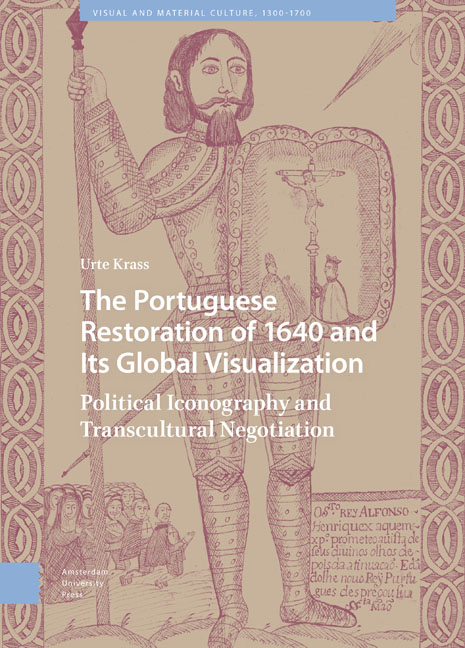 The Portuguese Restoration of 1640 and Its Global Visualization
The Portuguese Restoration of 1640 and Its Global Visualization Published online by Cambridge University Press: 13 February 2024
Abstract: The chapter reconstructs the material and visual framework of the new king's juramento ceremony, which took place in the square in front of the Lisbon palace. A variety of objects and visual media were used to convey the abstract royal oath of office to the audience. The textile decorations of specially erected pedestals and the lineup of political protagonists are meticulously reported upon in contemporary sources, possibly to counteract the previous episode of political disorder with a re-established order. The fact that a statue of the nebulous figure of Gonçalo Anes Bandarra was subsequently placed on the altar in the cathedral can be understood as an attempt to locate the new political situation between inherited iconographies and innovative visualizations.
Keywords: juramento, oath-taking ceremony, tapestry, personifications, regalia, Gonçalo Anes Bandarra
Following the coup d’état of 1 December 1640, Lisbon's residents expressed their great joy at the proclamation of the new king with bonfires, parades, and, as the Restauraçao de Portugal prodigiosa tells us, “other festive inventions.” The king entered the city triumphantly on 6 December. Some say heavy rain did not prevent masses of people from streaming into the streets, while another account informs us that, on the contrary, rather few people even noticed the Count of Braganza's arrival in the city. Be that as it may, the new king entered the palace and showed himself at the same window where, five days before, independence from Spain had been proclaimed. Salutes were fired from the Castelo Sao Jorge, and in the evening the city flowed in the light of festive bonfires. The “largest festival ever seen” was celebrated over three days, and Saturday 15 December was chosen as the day for the king's official swearing-in ceremony. Although most of the scholarly literature refers to this event as the coronation, John IV was not crowned, but simply elevated to king and sworn in legally—levantamento and juramento are the terms used in the reports. This fact is remarkable, since it involves a conscious decision by the Portuguese not to distance themselves in this respect from Spain: since 1370, Spanish kings were only crowned in exceptional circumstances, a formal oath before the assembly of the estates, the Cortes, replacing this act. In Portugal, however, until 1580, kings had been both crowned and anointed. This changed with the Restoration. John IV's assumption of power was thus marked by the ritual of oath-taking.
To save this book to your Kindle, first ensure [email protected] is added to your Approved Personal Document E-mail List under your Personal Document Settings on the Manage Your Content and Devices page of your Amazon account. Then enter the ‘name’ part of your Kindle email address below. Find out more about saving to your Kindle.
Note you can select to save to either the @free.kindle.com or @kindle.com variations. ‘@free.kindle.com’ emails are free but can only be saved to your device when it is connected to wi-fi. ‘@kindle.com’ emails can be delivered even when you are not connected to wi-fi, but note that service fees apply.
Find out more about the Kindle Personal Document Service.
To save content items to your account, please confirm that you agree to abide by our usage policies. If this is the first time you use this feature, you will be asked to authorise Cambridge Core to connect with your account. Find out more about saving content to Dropbox.
To save content items to your account, please confirm that you agree to abide by our usage policies. If this is the first time you use this feature, you will be asked to authorise Cambridge Core to connect with your account. Find out more about saving content to Google Drive.